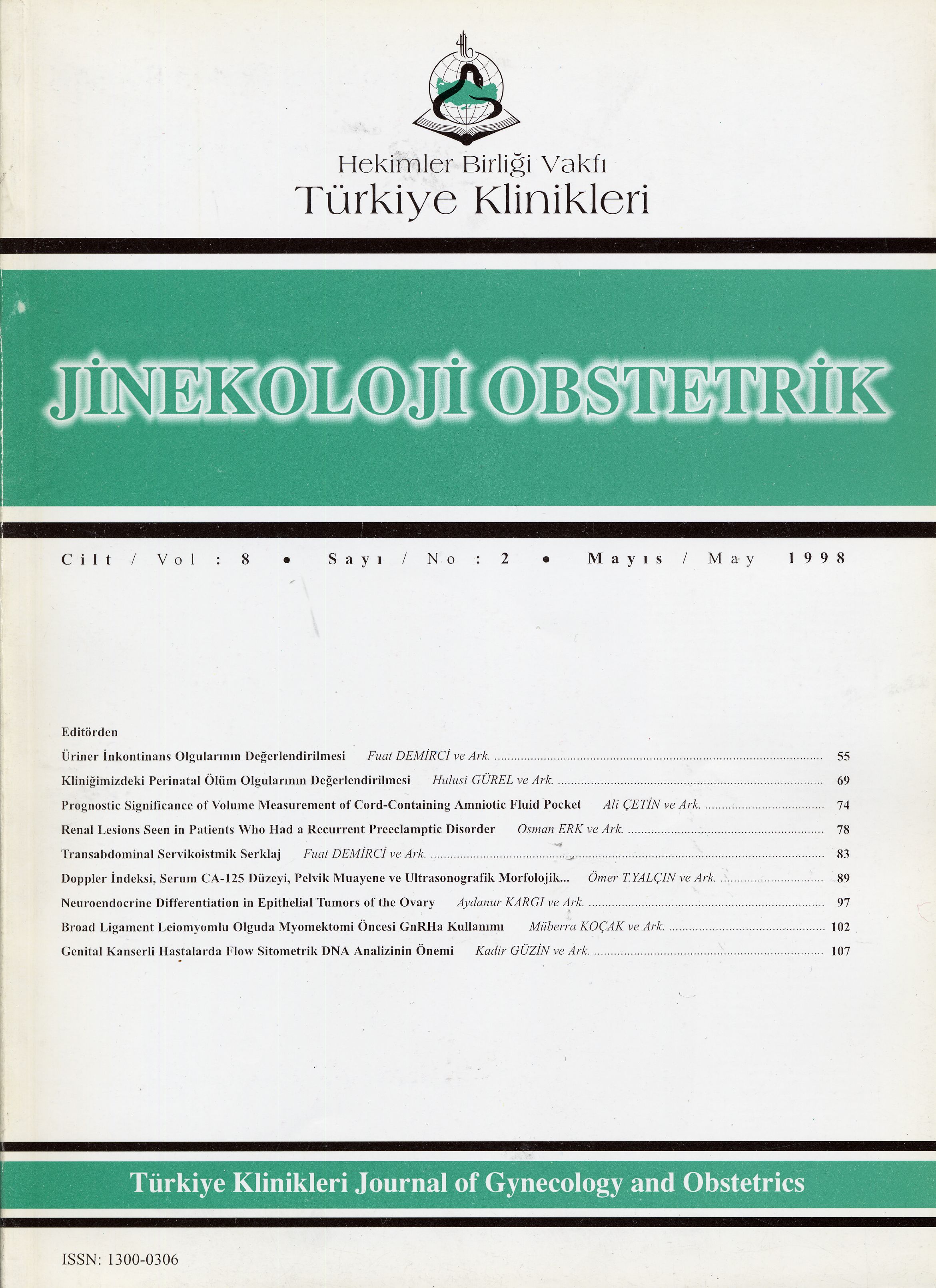Open Access
Peer Reviewed
ARTICLES
3132 Viewed1003 Downloaded
Neuroendocrine Differentiation in Malignant and Low Malignant Potential Epithelial Tumors of the Ovary
Overi̇n Mali̇gn Ve Düşük Mali̇gni̇te Potansi̇yelli̇ Epi̇telyal Tümörleri̇nde Nöroendokri̇n Di̇fferansi̇asyon
Turkiye Klinikleri J Gynecol Obst. 1998;8(2):97-101
Article Language: TR
Copyright Ⓒ 2025 by Türkiye Klinikleri. This is an open access article under the CC BY-NC-ND license (http://creativecommons.org/licenses/by-nc-nd/4.0/)
ÖZET
Amaç: Akciğer ve prostat tümörleri gibi değişik organların tümörlerinde nöroendokrin diferansiasyon bildirilmiştir. Epitelyal over tümörlerinde nöroendokrin diferansiasyon ile ilgili çalışma sayısı sınırlıdır. Nöroendokrin diferansiasyonun prognoz üzerine etkisi belirgin değildir. Bu çalışmanın amacı overin malign ve düşük malignite potansiyelli epitelyal tümörlerinde nöroendokrin diferansiasyon sıklığını saptamak ve nöroendokrin diferansiasyon gösteren ve göstermeyen olguları evre yönünden karşılaştırmaktır. Yöntem: 20 malign ve 5 borderline over epitelyal tümörü streptavidin biotin immünperoksidaz yöntemi ile Nöron Spesifik Enolaz, Kromogranin A, Kalsitonin ve Serotonin primer antikorları ile boyanmıştır. Bulgular: Malign olguların %35inde ve borderline olguların %5inde en az bir nöroendokrin belirleyici ile olumlu boyanma elde edilmiştir. Malign tümörlerde nöroendokrin diferansiasyon gösteren olgularda evrenin nöroendokrin diferansiasyon göstermeyen olgulara göre anlamlı derecede yüksek olduğu izlenmiştir. Sonuç: Overin invaziv epitelyal tümörlerinde nöroendokrin diferansiasyon evre ile ilişkili ve prognozla ilgili bir başka faktör olabilir.
Amaç: Akciğer ve prostat tümörleri gibi değişik organların tümörlerinde nöroendokrin diferansiasyon bildirilmiştir. Epitelyal over tümörlerinde nöroendokrin diferansiasyon ile ilgili çalışma sayısı sınırlıdır. Nöroendokrin diferansiasyonun prognoz üzerine etkisi belirgin değildir. Bu çalışmanın amacı overin malign ve düşük malignite potansiyelli epitelyal tümörlerinde nöroendokrin diferansiasyon sıklığını saptamak ve nöroendokrin diferansiasyon gösteren ve göstermeyen olguları evre yönünden karşılaştırmaktır. Yöntem: 20 malign ve 5 borderline over epitelyal tümörü streptavidin biotin immünperoksidaz yöntemi ile Nöron Spesifik Enolaz, Kromogranin A, Kalsitonin ve Serotonin primer antikorları ile boyanmıştır. Bulgular: Malign olguların %35inde ve borderline olguların %5inde en az bir nöroendokrin belirleyici ile olumlu boyanma elde edilmiştir. Malign tümörlerde nöroendokrin diferansiasyon gösteren olgularda evrenin nöroendokrin diferansiasyon göstermeyen olgulara göre anlamlı derecede yüksek olduğu izlenmiştir. Sonuç: Overin invaziv epitelyal tümörlerinde nöroendokrin diferansiasyon evre ile ilişkili ve prognozla ilgili bir başka faktör olabilir.
ANAHTAR KELİMELER: Over neoplazileri, Nöroendokrin diferansiasyon
ABSTRACT
Purpose: Neuroendocrine differentiation has been reported in various non neuroendocrine organ tumors such as lung and prostate tumors. However there are only a few studies dealing with neuroendocrine differentiation in epithelial ovarian neoplasms. The influence of neuroendocrine differentiation on the prognosis is not clear. The objective of this study is to evaluate the frequency of neuroendocrine differentiation in malignant and low malignant potential ovarian tumors, and to find out if there is any difference between the tumors with neuroendocrine differentiation and the tumors which do not show this finding , in terms of tumor stage. Method: 20 malignant and 5 borderline tumors were stained with neuroendocrine markers; Neuron Spesific Enolase, Chromogranin A, Calcitonin and Seratonin primary antibodies by streptavidin biotin immune peroxidase method. Results: Thirty five percent of malignant and fifty percent of tumours with low malignant potential were positive with at least one neuroendocrine marker. Among malignant tumours, the tumour stages were higher in tumors with neuroendocrine differentiation and showed statistically significant difference when compared with the stages of the tumors with negative neuroendocrine markers. Conclusion: Neuroendocrine differentiation may be another factor related to stage and may be an account on to prognosis in ovarian invasive epithelial tumors.
Purpose: Neuroendocrine differentiation has been reported in various non neuroendocrine organ tumors such as lung and prostate tumors. However there are only a few studies dealing with neuroendocrine differentiation in epithelial ovarian neoplasms. The influence of neuroendocrine differentiation on the prognosis is not clear. The objective of this study is to evaluate the frequency of neuroendocrine differentiation in malignant and low malignant potential ovarian tumors, and to find out if there is any difference between the tumors with neuroendocrine differentiation and the tumors which do not show this finding , in terms of tumor stage. Method: 20 malignant and 5 borderline tumors were stained with neuroendocrine markers; Neuron Spesific Enolase, Chromogranin A, Calcitonin and Seratonin primary antibodies by streptavidin biotin immune peroxidase method. Results: Thirty five percent of malignant and fifty percent of tumours with low malignant potential were positive with at least one neuroendocrine marker. Among malignant tumours, the tumour stages were higher in tumors with neuroendocrine differentiation and showed statistically significant difference when compared with the stages of the tumors with negative neuroendocrine markers. Conclusion: Neuroendocrine differentiation may be another factor related to stage and may be an account on to prognosis in ovarian invasive epithelial tumors.
MENU
POPULAR ARTICLES
MOST DOWNLOADED ARTICLES





This journal is licensed under a Creative Commons Attribution-NonCommercial-NoDerivatives 4.0 International License.










